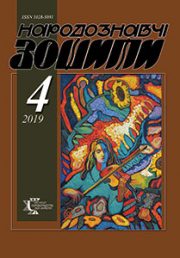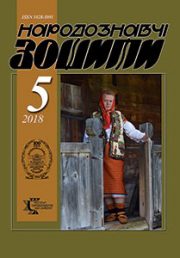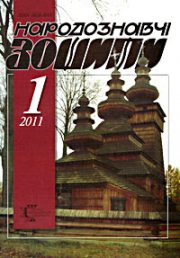The Ethnology Notebooks. 2022. № 1 (163), 138—151
UDK 930.2:398.341-035.3(477.83+477.85/.87=161.2)
DOI https://doi.org/10.15407/nz2022.01.138
BELIEFS ARE CONNECTED WITH SOME CONSTRUCTIVE ELEMENTS OF HOUSING OF UKRAINIAN MOUNTAINEERS
Nakonechna (Hoshchitska) Tetiana
- ORCID ID: https://orcid.org/0000-0001-8596-8974
- Doctor of Philosophy, researcher fellow, Institute of Ethnology
- The National Academy of Sciences of Ukraine,
- department of Historical Ethnology,
- 15, Svobody Avenue, 79000, Lviv, Ukraine,
- Contacts: e-mail: hoshchitska.tetiana@gmail.com
Abstract. Relevance: Housing in the popular consciousness of Ukrainians, as an ethnic group with an extremely long tradition of a settled way of life, was extremely important. It served not only as a shelter for man, which provided protection from adverse weather conditions, enemies, etc. The construction of one’s own home, the observance of living conditions was an important part of the social realization of the individual as a good host and worthy of respect for a member of the rural community. Accordingly, the process of its construction was accompanied by a complex set of ritual actions, which are commonly referred to construction rituals. Part of it consists of beliefs and ideas related to individual, important structural elements of housing, such as doors, thresholds, windows, slums.
In the proposed research, the author aims to highlight various beliefs and ideas related to some constructive elements of housing. Accordingly, the object of research is a complex of traditional rituals of the Ukrainians of the Carpathians, and the subject — the constructive elements of housing, which often acquire symbolic functions, a certain sacred significance. The main methods used by the author are structural-functional and comparative, as well as other methods of ethnological science.
Scientific novelty: Various beliefs and ideas related to household items made of wood are comprehensively analyzed, and the specifics of their existence in the traditional ritual culture of Ukrainian mountaineers are analyzed. The place occupied by certain constructive elements of housing in the traditional consciousness has been studied.
Conclusion: It was found that the most ritually significant door was the place of entrance to the house, a kind of boundary between external and internal, inhabited space.
Results: This was already evident at the stage of construction, when certain sacrificial objects were placed under the place of the future threshold. Also, the canvas of the door or the space around them was decorated with artistic carvings, with traditional apotropaic motifs (images of six-petalled rosettes, a cross), and the process of entering the house was regulated by a number of prohibitions and signs. Instead, the window, as in Slavonic in general, served as an alternative entrance, invisible to «evil forces», and, in the ritual sense, was a place of «communication» with the afterlife such as thresholds, doors, windows), which in the traditional ideas of the mountaineers acted as a kind of «borders» of home, inhabited space, and served as the main and alternative, «invisible» to evil forces entering the house, and were a place of «communication» with the afterlife.
Keywords: traditional rites, Ukrainian Carpathians, beliefs related to housing, doors, windows, threshold.
Received 18.01.2022
REFERENCES
- Siletskyy, R. (2011). Тraditional bulding rites of Ukraine. Lviv: LNU of I. Franko [in Ukrainian].
- Davydiuk, V. (2009). «As There Was Nothing When the World Arose…» (On World-Creative Motives in Habituated Space of Polisian and Carpathian Ukrainians). The ethnology notebooks, 1—2, 110—114 [in Ukrainian].
- Rybakov, B.A. (1988). Paganism of ancient Rus’. Моscow: Nauka [in Russian].
- Stankevych, M. (2006). Ukrainian artistic tree. In Ethnogenesis and ethnic history of the Ukrainian Carpathians (Vol. 2, pp. 709—726). Lviv: In-tut narodoznavstva NANU [in Ukrainian].
- Samojlovych, P.A. (1977). Folk architectural creativity (Based on materials from the Ukrainian SSR). Kyiv: Budivel’nyk [in Russian].
- Sokil, V., & Sokil, H. (1998). Folklore materials from the fatherland. Lviv [in Ukrainian].
- Svitluk, P.M. (2008). Heavenly Well: Transcarpathian folk traditions, legends, beliefs, customs, traditions and life. Uzhhorod: Grazda [in Ukrainian].
- Franko, I. (1898). Popular beliefs in Pidhiria. Etnohrafichnyj zbirnyk (Vol. V, pp. 160—218) [in Ukrainian].
- Zubryts’kyj, M. (1912). Funerals customs and ceremonies in Msantsi and neighboring villages Starosambirsk and Turchany counties Etnohrafichnyj zbirnyk (Vol. ХXXI—XXXII, pp. 211—226) [in Ukrainian].
- Kmit, Yu. (1934). Folk «pбts’ir’y». In Litopys Bojkivschyny: zapysky prysviacheni doslidam istorii, kul’tury i pobutu bojkivs’koho plemeni (Vol. V, part 5, pp. 36—37) [in Ukrainian].
- Stelmakh, M. (Ed.). (1971). Folk pearls. Kyiv: Dnipro [in Ukrainian].
- (2011). From a parent source. To the anniversary of the comprehensive school I—III centuries, the village of Pidgorodtzi, Skole district, Lviv region. Lviv: Podgorodtzi [in Ukrainian].
- Shahala, V. (2002). Stories and illustrations about life in the countryside in Western Ukraine. Lviv [in Ukrainian].
- Markiv, M. (1934). MISHCELLANEA. In Litopys Bojkivschyny: zapysky prysviacheni doslidam istorii, kul’tury i pobutu bojkivs’koho plemeni (Vol. IV, part 4, p. 76) [in Ukrainian].
- Ganus, D.M. (2015). A child in the system of folk beliefs and rituals of the population of the Ukrainian-Polish border. The thesis for the academic degree of Doctor of Historical Sciences with a specialization in Ethnology. Kyiv [in Ukrainian].
- Boryak, O. (1997). Weaving in the rites and beliefs of Ukrainians (mid-nineteenth — early twentieth century). Kyiv [in Ukrainian].
- Silets’kyj, R. (2001). Customs and rites associated with the construction of a house in the Stary Sambir region. Old Sambir: an almanac (Pр. 57—62)[in Ukrainian].
- Cherleniak (Kerechanyn), I. (2018). Protective action for alive and magik action connected with the birial of the deceased of the Transcarpatian Ukrainians. The ethnology notebooks, 3, 662—670 [in Ukrainian].
- Zynych, M. (1935). Funeral customs in the village of Zhukotin in the Turkish district. In Litopys Bojkivschyny: zapysky prysviacheni doslidam istorii, kul’tury i pobutu bojkivs’koho plemeni (Vol. V, part 6, pp. 14—18) [in Ukrainian].
- Halaychuk, V. (2010). From the Spiritual Culture of Bohorodchany Region: Customs, Beliefs and Legends Related to the Conceptual Representation of Death and the Dead. Mythology and Folklore, 3—4 (7), 27—49 [in Ukrainian].
- Perejma, T. (1912). Funeral customs and ceremonies in villages Ropytsy Rus’kij, Horlyts’koho povita. Etnohrafichnyj zbirnyk (Vol. ХXXI—XXXII, pp. 203—210) [in Ukrainian].
- Okhrimovuch, O. (1912). Funeral customs and ceremonies in villages Voloshyantsy, Skilsky district. Etnohrafichnyj zbirnyk (Vol. ХXXI—XXXII, pp. 226—231) [in Ukrainian].
- Goroshchko, L. (2003). Field materials before topic of «Сalendar and family custom and ceremonies» from the expedition to the Drohobyts’kyj district, L’vivs’koi area and Kosivs’kyj district, Ivano-Frankivs’koi area). In Archive of the IN NANU. F. 1. Оp. 2. Od. save 513. Arc. 1—73 [in Ukrainian].
- Fischer, A. (1928). Rusini: outline of ethnography of Rus. Lviv; Warsawa; Krakow [in Polish].
- Kolomyjchenko, F. (1912). Funeral customs and ceremonies in villages Prokhorakh, Borzens’koho pov., Chernyhivs’koi gubernii. Etnohrafichnyj zbirnyk (Vol. ХXXI—XXXII, pp. 392—403) [in Ukrainian].
- Onyschuk, A. (1912). Funeral customs and ceremonies in villages Zelenytsya, Nadvirna district. Etnohrafichnyj zbirnyk (Vol. ХXXI—XXXII, pp. 231—252) [in Ukrainian].
- Ganus, D.M. (2015). A child in the system of folk beliefs and rituals of the population of the Ukrainian-Polish border (Dissertation). Ivan Krypiakevych Institute of Ukrainian Studies of the National Academy of Sciences of Ukraine [in Ukrainian].
- Dragun, Yu. (2017). Oh, a wreath of periwinkle: customs, rituals, kolomyyky of the Carpathians. Uzhhorod [in Ukrainian].
- Nykorak, O. (2003). Traditional fabrics in the customs and rites of Ukrainians. Bulletin of Lviv University. The series are historical, 38, 543—567) [in Ukrainian].
- Schnaider, J. (1906) People of Pechenizhyn. Lud (Vol. XII, pp. 277—309) [in Polish].
- Yakivchuk, A. (2010). Wedding in the village of Goshova. Record 1966 In: Chronicle of Borshchiv region (Issue 10, pp. 18—57) [in Ukrainian].
- Mysevych, O. (1937). Ukrainian wedding ceremony in Boykivshchyna. Lviv [in Ukrainian].
- Zborovs’kyj, P. (2015). Legends, tricks and tales from Turkovshchyna. Lviv [in Ukrainian].
- Vynohradova, L.N., & Tolstaia, S.M. (1995) Door. Slavic antiquities: Ethnolinguistic dictionary (Vol. 2, pp. 25—29). Moscow: Mezhdunarodnyye otnosheniya [in Russian].
- Ziubrovs’kyj, A. (2005). Field materials before topic of «Native architecture» from the expedition to the Starosambirs’kyj district, Lviv area). In Archive of the HF LNU. F. 119. Оp. 17. Od. save 124-E. Arc. 1—60 [in Ukrainian].
- Zubryts’kyj, M. (1895). Houses and masters. Zhytie i slovo: vistnyk literatury, istorii i fol’kloru, 3, 71—75 [in Ukrainian].
- Galaychuk, V. (2016). Ukrainian mythology. Kharkiv: Family Leisure Club [in Ukrainian].
- Levkievskaya, E.E. (2002). Slavic amulet. Semantics and structure. Моscow: Indrik [in Russian].
- Voitovich, N. (2015). Folk Demonology of Boykivshchyna. Lviv [in Ukrainian].
- Goroshchko, L. (2005). Field materials before topic of «Сalendar and family custom and ceremonies» from the expedition to the Skolivs’kyj, Turkivs’kyj district, L’viv area, Verkhovyns’kyj district Ivano-Frankivs’koi area, Vyzhnyts’kyj, Putyl’s’kyj district, Chernivets’koi area, Rakhivs’kyj, Velykobereznians’kyj district, Zakarpats’koi area). In Archive of the IN NANU. F. 1. Оp. 2. Od. save 533. Arc. 1—183 [in Ukrainian].
- Huzij, R., Varkhol, J., & Varkhol, N. (2002). Funeral ceremonies. In Lemkivschyna (Vol. 2, pp. 94—109). Lviv: In-tut narodoznavstva NANU [in Ukrainian].
- Nebesna, Z. (2010). Boykivshchyna’s Puerperal Customs. Time History of the Rites in the XXth—XXIst Centuries. Narodna tvorchist’ ta etnolohiia, 6, 40—46 [in Ukrainian].
- Silets’kyj, R (1995). Customs and rites in the folk building of the Ukrainians of the Carpathians. The ethnology notebooks, 2, 86—89 [in Ukrainian].
- Toporkov, A.L. (2002). Window. Slavic mythology: Encyclopedic dictionary. (Pр. 339—341). Моscow [in Russian].
- Nakonechna, T. (2004). Field materials before topic of «Traditional architecture» from the expedition to the Stryjs’kuj district, L’vivs’koi area 25—30.08.2004). In Archive of the IN NANU. F. 1. Оp. 2. Od. save 522. Arc. 1—16 [in Ukrainian].
- Nemets’, V. (2008). Field materials before topic of «Wedding ceremony» from the expedition to the Bohorodchans’kyj district, Ivano-Frankivs’koi area, 11—17.07.2008). In Archive of the HF LNU. F. 119. Op. 17. Od. save 299-E. Arc. 1—118 [in Ukrainian].
- Falkowski, J. (1937). On the west border of Hutsylshchuna: on the wallej of Prut, Bystrzyca Nadwornianska, Bystrzyca Solotwinkia i Lomnica. Lviv [in Polish].
- Goshchitska, T. (2008). Field ethnographic materials on the theme «People’s construction», collected in the Skole district of Lviv region. In Archive of the IN NANU. F. 1. Оp. 2. Od. save 576. Arc. 1—72 [in Ukrainian].
- Goshchitska, T. (2009) Field materials before topic of «Native arxitekture» from the expedition to the Drohobyts’kyj, Stryjs’kyj, Skolivs’kyj district, L’vivs’koi area ta Rozhniativs’kyj district, Ivano-Frankivs’koi area). In Archive of the IN NANU. F. 1. Оp. 2. Od. save 595. Arc. 1—95 [in Ukrainian].
- Kmit, Yu. (1915). Funerals customs and ceremonies from bojko. ZNTS (Vol. CXXII, pp. 161—166) [in Ukrainian].
- Serebriakova, O.H. (2015). Marriage mantica in the calendar rituals of Ukrainians: typology and semantics. The thesis for the academic degree of Doctor of Historical Sciences with a specialization in Ethnology. Lviv [in Ukrainian].
- Kolessa, F. (1898). Popular beliefs in Pidhiria in the Khodovychi village, Stryi povit, recorded by Filaret Kolessa. Etnohrafichnyj zbirnyk (Vol. V, pp. 76—98) [in Ukrainian].
- Derkach, V. (1912). Funerals customs and ceremonies in villages Verbivtsi, Terebovelsky district. Etnohrafichnyj zbirnyk (Vol. ХXXI—XXXII, pp. 369—378) [in Ukrainian].
- Vasilechko, L. (2003). Paths of echo. Ivano-Frankivsk [in Ukrainian].
- Shekeryk-Donnykiv, P. (2009). The year in beliefs of Hutsuls. Verkhovyna [in Ukrainian].
- Nesen, I. (2015). Polissye Cemeteries: Traditions and Modernity. In Folk culture of Ukrainian: life cycle of people. Age. Death. Culture of worshiping the dead) (Vol. 5, pp. 288—297). Kyiv: Duliby [in Ukrainian].
- Kulish, P. (2015). The funeral written off from the words of the peasant, in the Kharkov province. In Folk culture of Ukrainian: life cycle of people. Age. Death. Culture of worshiping the dead) (Vol. 5, pp. 401—405). Kyiv: Duliby [in Ukrainian].
- Onischuk, А. (1909). Materials to the Hutsul demonology, written in 1907—1908 in Zelenitsy, Nadvirna district by Antin Onischuk, the folk teacher. Materiialy do ukrains’koi etnol’ohii (Vol. ХІ, pp. 1—139) [in Ukrainian].
- Nakonechna, T. (2005). Field materials before topic of «Native arxitekture» from the expedition to the Starosambirskyy district, L’vivs’koi area 06.07—10.08.2005). In Archive of the IN NANU. F. 1. Оp. 2. Od. save 522-a. Arc. 1—48 [in Ukrainian].
- Miloradovich, V.P. (1991). Life and life of the Lubensk peasant. In: Ukrainians: folk beliefs, superstitions, demonology (Pр. 170—341). Kyiv: Lybid [in Russian].
- The Illustrative Fund of the Science Library to the Institute of National Science of the National Academy of Sciences of Ukraine, unit save 14568 [in Ukrainian].
- Goshchitska, T. (2010). Field materials before topic of «Native arсhitekture» from the expedition to the Skolivs’kyj district, L’viv area, Dolyns’kyj, Kalus’kyj district, Ivano-Frankivs’k area 01—15.07.2010). In Archive of the IN NANU. F. 1. Оp. 2. Od. save 601a. Arc. 1—50 [in Ukrainian].
- Stankevych, M. (2002). Ukrainian artistic tree XVI—XX st. Lviv: In-tut narodoznavstva NANU [in Ukrainian].
- Goshchitska, T. (2007). Field materials before topic of «Native arсhitekture» from the expedition to the Starosambirs’kyj, Sambirs’kyj district, L’viv area, 16.06.—16.08.2007). In Archive of the IN NANU. F. 1. Оp. 2. Od. save 563. Arc. 1—146 [in Ukrainian].
- Uzeneva, E.S. (1995). Girder. Slavic antiquities: Ethno linguistic dictionary (Vol. 3). Moscow: Mezhdunarodnyye otnosheniya (Pр. 201—203) [in Russian].
- Hoschits’ka, T. (2009). The choice of building material and construction sites on the Boyko-Pidhirtsi border in the second half of the XIX century — the first half of the XX century. The ethnology notebooks, 5—6, 783—791 [in Ukrainian].
- Shevchenko, L. (1926). Customs associated with the foundations of the building. Primitive citizenship and its remnants in Ukraine (Issue 1—2, pp. 87—95) [in Ukrainian].
- Radovych, R. (1995). Traditional rural housing of Pidhirya late XIX — early XX century. The ethnology notebooks, 4, 221—225 [in Ukrainian].
- Boltarovych, Z. (2005). Expedition diary pages. The ethnology notebooks, 1—2, 197—202 [in Ukrainian].







